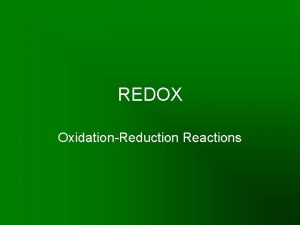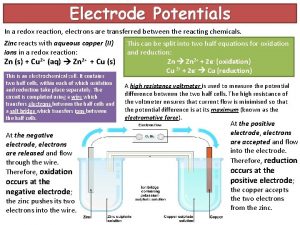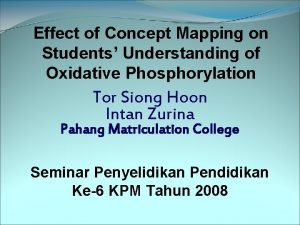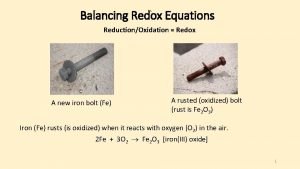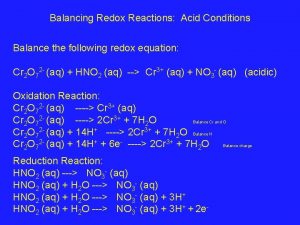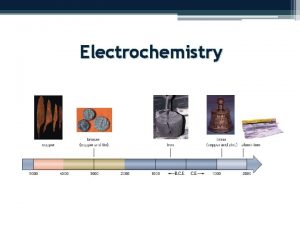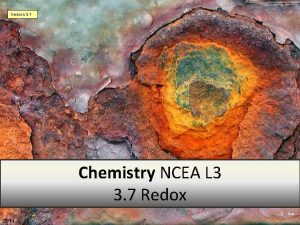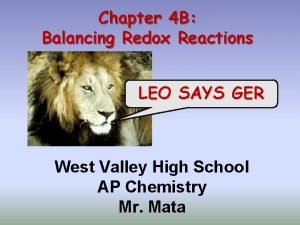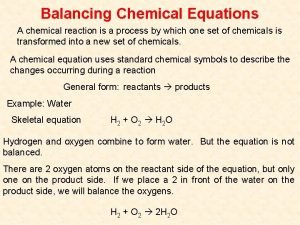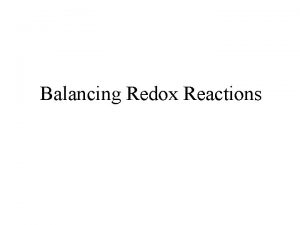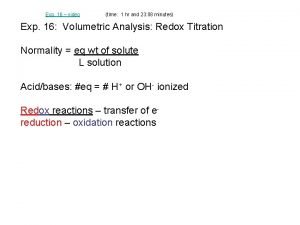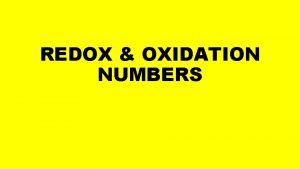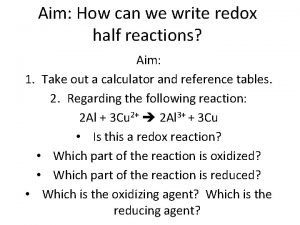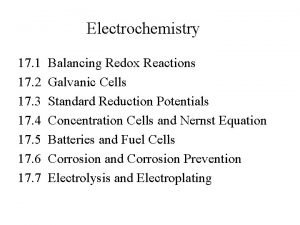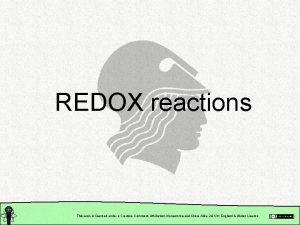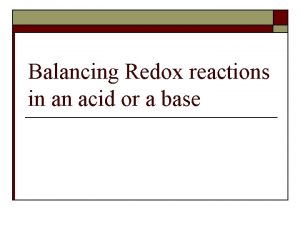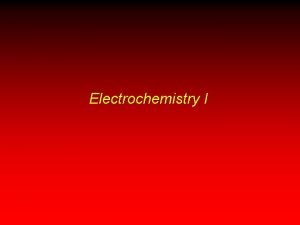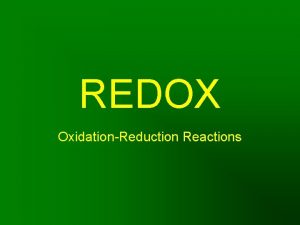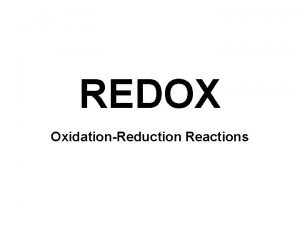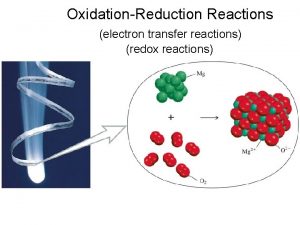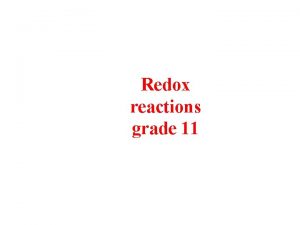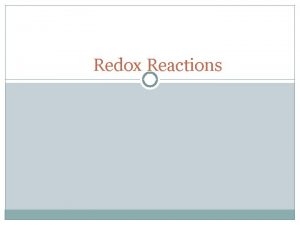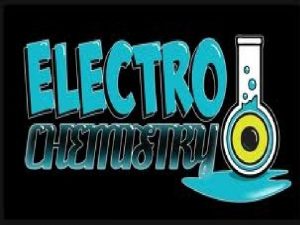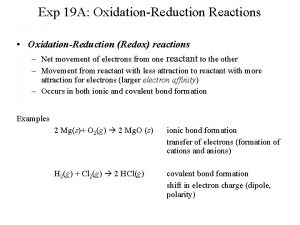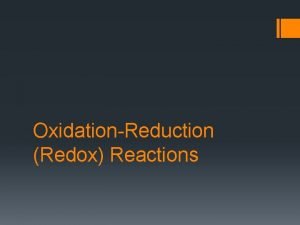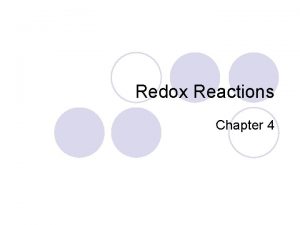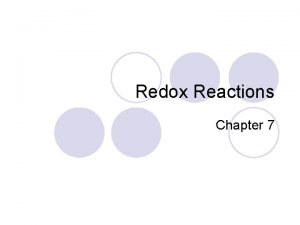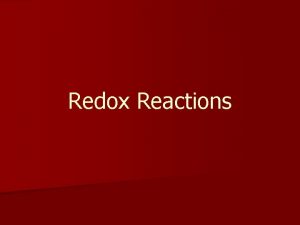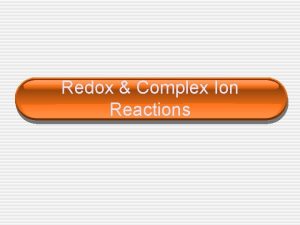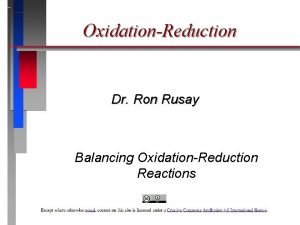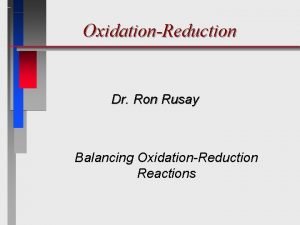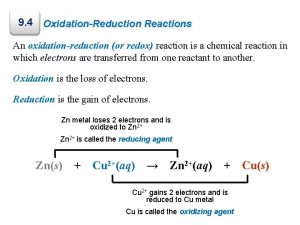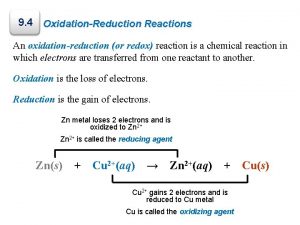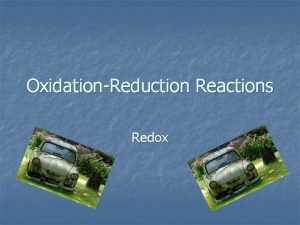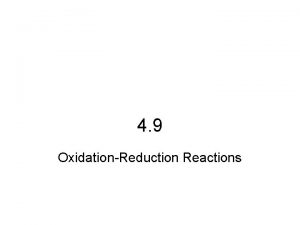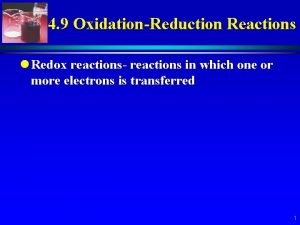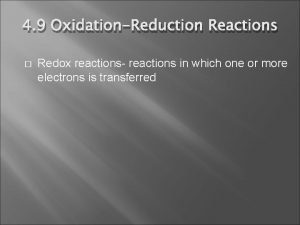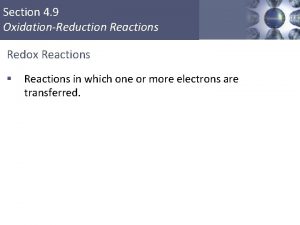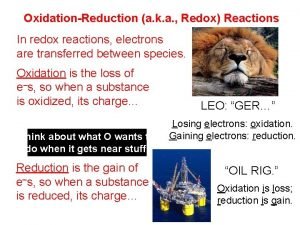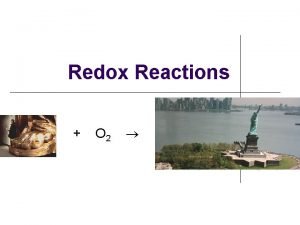REDOX OxidationReduction Reactions OxidationReduction Reactions Electrons are transferred




























- Slides: 28

REDOX Oxidation-Reduction Reactions

Oxidation-Reduction Reactions • Electrons are transferred from 1 atom to another. • All single-replacement & combustion rxns are redox rxns.

Oxidation = loss of electrons. LOSS of ELECTRONS = OXIDATION LEO

Reduction = gain of electrons. GAIN of ELECTRONS = REDUCTION GER

REDOX • Oxidation & Reduction are complementary. • They occur together & simultaneously or not at all.

LEO GOES GER!!! Oxidation of Cu

Oxidation Numbers • In Ionic Compounds: the number of electrons lost or gained by an atom when it forms ions. Oxidation states of Vanadium

Assigning Oxidation Numbers

8 Rules for Oxidation Numbers 1. of a free, uncombined element = 0. Na He O 2 N 2 S 8 Cl 2 2. of a monatomic ion = charge on ion. +2 -1 +3 P Ca = +2. Cl = -1. Al = +3. Remember: Ions occur in ionic compounds: Ca. Cl 2, Al(NO 3)3, etc.

8 Rules for Oxidation Numbers 3. Fluorine is always -1. CF 4 4. Hydrogen is nearly always +1, except when it’s bonded to a metal. Then it’s -1. H 2 O, HNO 3, H 2 SO 4 Li. H Ca. H 2 Na. H

8 Rules for Oxidation Numbers 5. Oxygen is nearly always -2 except when its -Bonded to fluorine, where O is +2 OF 2 -In the peroxide ion, where O is -1. O 22 -

8 Rules for Oxidation Numbers 6. The sum of oxidation numbers in a neutral compound is 0. H 2 O CO 2 NO SO 3 7. The sum of oxidation numbers in a polyatomic ion = charge of the ion. Sum in SO 42 - = -2. Sum in NO 3 - = -1.

8 Rules for Oxidation Numbers 8. In covalent compounds, the oxidation number of the more electronegative atom is the negative charge it would have if it was an ion. *NH 3: N = -3, H = +1. Si. Cl 4: Si = +4, Cl = -1.

Assign Oxidation Nos • • • K = +1, Cl = -1 KCl Ca. Br 2 Ca = +2, Br = -1 CO C = +2, O = -2 C = +4, O = -2 CO 2 Al(NO 3)3 Al = +3, O = -2, N = +5 Na 3 PO 4 Na = +1, O = -2, P = +5 H 2 S H = +1, S = -2 NH 4+1 N = -3, H = +1 SO 3 -2 S = +4, O = -2

Electrons are Negative! • Why do we use the word “reduced” when electrons are gained? Look at how the oxidation number changes. For example, if Cl gains an electron it becomes Cl-1. The oxidation number decreased from 0 to -1. The oxidation number was reduced.

Writing Equations • Even though oxidation & reduction occur together, we can write separate equations for each process. • Called Half-Reactions. • In order to balance a redox equation, we have to split the full equaton into halfreactions.

Conservation of Mass • # of atoms of each type is the same on both sides of the equation. • Still holds for half-reactions. • Do this step first.

Conservation of Charge • Total charge on LHS must equal total charge on RHS. • In the past, we usually had both sides neutral. (0 = 0. ) • Note: Total charge can be nonzero. Just has to be equal on the 2 sides. • If not balanced, add electrons to whichever side is too positive.

Reduction Half-Reactions Electrons are gained so • I 2 + 2 e- 2 Ithey are like a reactant ! • O 2 + 4 e- 2 O-2 • Half-reactions must demonstrate conservation of mass & conservation of charge. • # of atoms of each element on LHS equals “ “ “ “ RHS. • Total charge on LHS = Total charge on RHS

Oxidation Half-reactions • K K 1+ + 1 e • Fe 2+ Fe 3+ + 1 e • Cu 2+ + 2 e- Electrons are lost so they appear on the product side! • Total Charge on LHS = Total Charge on RHS • # atoms LHS = # atoms RHS

Identifying Half-Reactions • Reduction: electron term is on reactant side. • Oxidation: electron term is on product side.

Vocabulary Interlude • Oxidizing Agent: Is itself reduced. Accepts electrons from something else – aids oxidation for another species. • Reducing Agent: Is itself oxidized. • Loses electrons to something else – aids reduction for another species.

Figuring out what is what! • Given an unbalanced equation. • Goal: Balance it. • Procedure: – Assign oxidation numbers to everything – Split into half-reactions – Balance them separately – “Match” the electrons – Add them together

What’s oxidized & what’s reduced? USE OIL RIG

4 3 2 1 0 -1 -2 -3 -4 2) And if you’re lucky you strike oil & it shoots up 1) You dig down with an oil rig

Oxidizing & Reducing Agents • They are both ALWAYS on the reactant side. • Identify them by seeing how the oxidation 4 numbers change. 3 0 +2 +2 0 Mg + Cu 2+ Mg 2+ + Cu Mg is oxidized, so Mg is the reducing agent! 2 1 0 -1 -2 -3 -4

Oxidizing & Reducing Agents • What’s oxidized & what’s reduced: 0 +2, -1 0 Ca + Fe. Cl 2 Ca. Cl 2 + Fe • Assign oxidation numbers • Figure out what increases & what decreases. Ca is oxidized; Fe 2+ is reduced. Ca = reducing agent; Fe. Cl 2 = oxidizing agnt. 4 3 2 1 0 -1 -2 -3 -4

Oxidizing & Reducing Agents 3, -1 2, -1 4, -1 2 Fe. Br 3 + Sn. Br 2 2 Fe. Br 2 + Sn. Br 4 Fe 3+ is reduced to Fe 2+ Sn 2+ is oxidized to Sn 4+ Fe. Br 3 is the oxidizing agent. Sn. Br 2 is the reducing agent.
 In a redox reaction, electrons are transferred
In a redox reaction, electrons are transferred In a redox reaction, electrons are transferred
In a redox reaction, electrons are transferred Insidan region jh
Insidan region jh Balancing redox reactions
Balancing redox reactions Chapter 19 review oxidation-reduction reactions
Chapter 19 review oxidation-reduction reactions Concept map redox reactions
Concept map redox reactions Activity series oxidation
Activity series oxidation Balance redox reactions
Balance redox reactions Cathode reaction
Cathode reaction Predicting redox reactions
Predicting redox reactions Redox reactions ncea level 2
Redox reactions ncea level 2 Leo and ger
Leo and ger Electrolytic cells khan academy
Electrolytic cells khan academy Types of redox reactions
Types of redox reactions How to balance equation in acidic solution
How to balance equation in acidic solution Lithium ion battery reaction equation
Lithium ion battery reaction equation Half equation worksheet with answers
Half equation worksheet with answers Balancing redox reactions
Balancing redox reactions What are spectator ions
What are spectator ions Redox oil rig
Redox oil rig How to write redox half reactions
How to write redox half reactions Downs cell
Downs cell How redox reactions work
How redox reactions work Balancing redox reactions in acid
Balancing redox reactions in acid Balancing redox reactions
Balancing redox reactions Balancing redox reactions in basic solution
Balancing redox reactions in basic solution Balancing redox reactions
Balancing redox reactions Types of reactions
Types of reactions Unit 5 chemical reactions answers
Unit 5 chemical reactions answers
